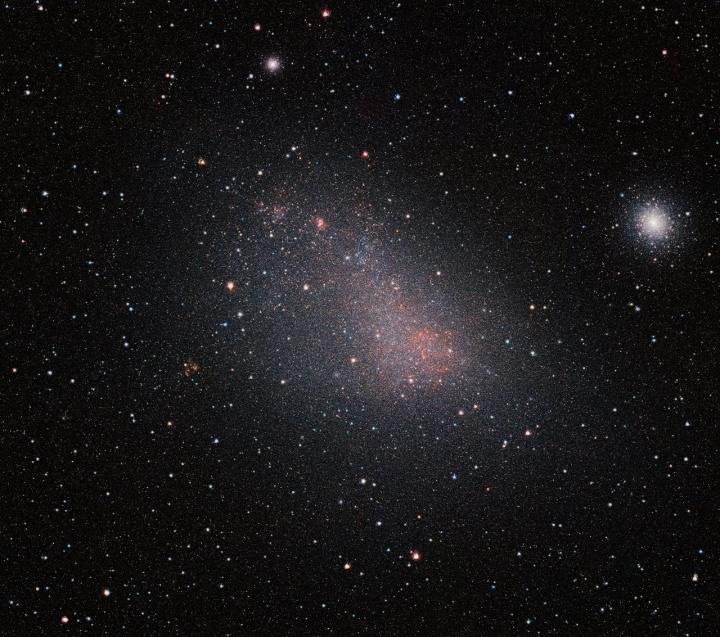May 4 2017
 The Small Magellanic Cloud (SMC) galaxy is a striking feature of the southern sky even to the unaided eye. But visible-light telescopes cannot get a really clear view of what is in the galaxy because of obscuring clouds of interstellar dust. VISTA's infrared capabilities have now allowed astronomers to see the myriad of stars in this neighbouring galaxy much more clearly than ever before. The result is this record-breaking image -- the biggest infrared image ever taken of the Small Magellanic Cloud -- with the whole frame filled with millions of stars. As well as the SMC itself this very wide-field image reveals many background galaxies and several star clusters, including the very bright 47 Tucanae globular cluster at the right of the picture. Credit: ESO/VISTA VMC
The Small Magellanic Cloud (SMC) galaxy is a striking feature of the southern sky even to the unaided eye. But visible-light telescopes cannot get a really clear view of what is in the galaxy because of obscuring clouds of interstellar dust. VISTA's infrared capabilities have now allowed astronomers to see the myriad of stars in this neighbouring galaxy much more clearly than ever before. The result is this record-breaking image -- the biggest infrared image ever taken of the Small Magellanic Cloud -- with the whole frame filled with millions of stars. As well as the SMC itself this very wide-field image reveals many background galaxies and several star clusters, including the very bright 47 Tucanae globular cluster at the right of the picture. Credit: ESO/VISTA VMC
The Small Magellanic Cloud (SMC) is a dwarf galaxy considered to be the more petite twin of the Large Magellanic Cloud (LMC). These are two of the closest galaxy neighbors in space with the SMC located about 200 000 light-years away, just a twelfth of the distance to the more famous Andromeda Galaxy. Both are strangely shaped due to the interactions with the Milky Way itself and also with one another.
Their relative proximity to Earth allows the Magellanic Clouds to be perfect candidates for analyzing how stars form and evolve. However, even though the distribution and history of star formation in these dwarf galaxies were known to be complicated, one of the biggest hindrances to obtaining clear observations of star formation in galaxies refers to interstellar dust. Huge clouds of these small grains scatter and absorb some of the radiation from the stars, particularly visible light, thus limiting what can be viewed by telescopes here on Earth. This is called dust extinction.
The SMC is filled with dust, and the visible light emitted by its stars experience major extinction. Luckily, the dust does not affect all electromagnetic radiation. Infrared radiation travels through interstellar dust in a more effortless manner than visible light, and hence by observing the infrared light from a galaxy it is possible to study the new stars developing within the clouds of dust and gas.
The Visible and Infrared Survey Telescope (VISTA) was designed to image infrared radiation. The VISTA Survey of the Magellanic Clouds (VMC) concentrates on mapping the star formation history of the LMC and SMC, and also concentrates on mapping their three-dimensional structures. Millions of SMC stars have been imaged in the infrared as the VMC provides an unparalleled view almost unaffected by dust extinction.
Stars belonging to the Small Magellanic Cloud fill the whole frame of this massive image. The frame also includes thousands of background galaxies and numerous bright star clusters, including 47 Tucanae at the right of the picture, which lies more closer to the Earth than the SMC. The zoomable image shows the SMC in a way never seen before.
An international team headed by Stefano Rubele of the University of Padova has studied the wealth of new information in this 1.6 gigapixel image (43 223 x 38 236 pixels). Cutting-edge stellar models were used to obtain some surprising results.
The VMC has revealed that several of the stars present inside the SMC developed far more recently than those in bigger neighboring galaxies. This early result from the survey is just a glimpse of the discoveries yet to be made in the future, as the survey continues to fill in blind spots in the of the Magellanic Clouds.